It’s fun to spot wildlife in nature, but sometimes we are only left with their evidence in the form of tracks, scat, burrows, holes and more. Today we are going to explore commonly encountered scat because…why not? Scat is animal poop, and not only can we identify animals by looking at their poop, but sometimes we can tell what they have been eating too! And, who doesn’t love to talk about poop?! We all do it. And, knowing which species are in your yard can be exciting, or slightly concerning. If you discover you have a coyote or bobcat in your yard, I encourage you to learn more about them and celebrate the fact your yard is supporting some of our larger mammal species!
One thing to keep in mind as I share scat measurements with you is that diameter (thickness) is usually a better metric to focus on versus length since diameters are more or less fixed based on the animal’s anatomy. Okay, let’s dive in…
White-Tailed Deer (Odocoileus virginianus)
White-tailed deer aren’t common in all parts of Pinellas County, but where they are, you are sure to find their scat. Despite being herbivores, you might not guess they only eat plants just by looking at their scat. If I had to describe deer scat, I would say it looks like black beans. These “beans” or pellets are often found in a scattered pile. It would look as if you dumped a can of beans on the floor, okay, maybe half a can 😉. When deer poop, they release several pellets at one time, falling into a pile, but scattering upon impact with the ground. They are small pellets, only about 3/16 to 5/8 of an inch in diameter and ½ inch to 1¾ inches long. These ranges in diameter and length can result in short and stout or long and skinny pellets. Deer scat may have an indentation at one end and be pointed at the other, or they can be rounded on both ends.
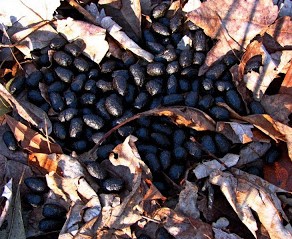
Just like human feces that can be quite variable based upon diet, the same applies to wildlife. In the case of deer feeding exclusively on plant material, moisture content of those plants can impact the consistency of scat. Higher moisture leads to looser and more unstructured scat which we might find in the rainy season (May-Oct). During the dry season, pellets become more distinct.
Northern Raccoon (Procyon lotor)
Raccoons can be found throughout Pinellas County. They are classified as carnivores but eat a significant amount of plant material. This variable diet leads to variable scat. Raccoon scat can be between 5/16 to 1 3/16 inches in diameter and 3 ½ to 7 inches long. You may be able to identify parts of fruit or plant fibers, or parts of insects, crabs, crayfish or fish. Raccoons are known for pooping in a communal area called a latrine. So, where you find one raccoon scat, you may find more. Latrines can be on the ground, in trees, on top of logs, or in water (yes, including your pool).
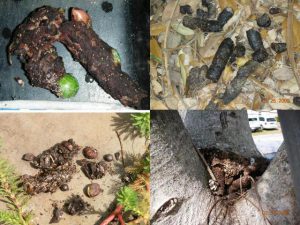
Coyote (Canis latrans)
Coyotes can also be found throughout Pinellas County. They are opportunistic omnivores, eating plants or animals based upon availability. This feeding behavior also lends itself to variable scat. If coyotes are mostly feeding on fruit, the scat tends to be smooth and tubular with blunt or tapered ends. If they are feeding mostly on meat and organs, scat will be loose, shapeless, crumbly and usually have blunt ends. Scat with hair and bones are easiest to identify since they maintain their shape. They tend to appear twisted and tapered with pointed ends. Coyotes will often defecate in obvious places like the middle of the road or trail, along regular travel routes, or near bedding or den sites.
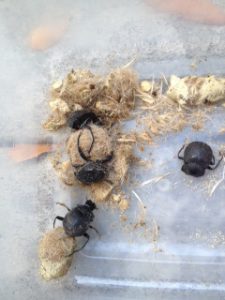
If you live in an area where foxes are also present, size can be a helpful factor to differentiate between the two. Fox scat is rarely larger than ¾ in in diameter. Coyote scat can range from 3/8 of an inch to 1 3/8 of an inch in diameter to 5-13 inches long!
Bobcat (Lynx rufus floridanus)
Bobcats are present in Pinellas County, but not often seen due to their nocturnal nature. They are carnivores so their diet isn’t as variable as raccoons and coyotes, making their scat more consistent. Bobcat poop is usually smooth, tubular, long ropes. The “ropes” are frequently segmented, often folding along the narrow portions of the segment or can sometimes be found as one length. The ends of the scat are usually blunt, but one end may be pointed. It is rare to find bobcat scat with any type of fruit or seeds in it, though occasionally, you may find some grass. Bobcat scat may be covered, resulting in a circular scrape around the droppings, about 12-18 inches long. Travel routes are often where bobcat scat will be found. The size of bobcat scat is 7/16 to 1 inch in diameter and 3-9 inches long.
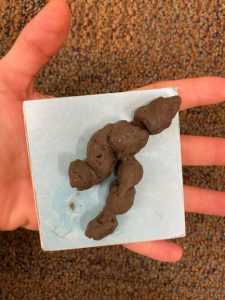
Eastern Cottontail Rabbit (Sylvilagus floridanus)
Eastern cottontail rabbits are herbivores, and like deer, their scat is deposited in the form of pellets. Rabbit pellets can easily be distinguished from deer by shape and color; they are light brown, round pellets or discs. While you may consider rabbits cute, you might not be as fond of them after learning they eat their own poop! Known as coprophagy (ingesting feces), rabbits partake in this activity to help them better digest plant materials. Grossness aside, the great thing about rabbit scat, is it’s easy to identify. The rabbit scat you see is typically the second round of poop; the first round (that gets eaten) is difficult to find. Unlike deer that expel multiple pellets at a time, rabbits excrete one pellet a time, forming a small pile. Each individual pellet measures between 3/16 and 7/16 of an inch in diameter.
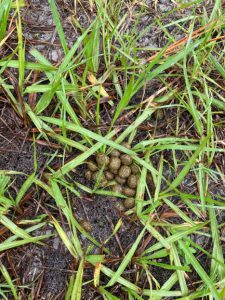
So, next time you see scat on the ground, take a closer look and see if you can identify which species it came from. Unsure? You can always send a picture to me at lara317@ufl.edu.
Sources: https://edis.ifas.ufl.edu/uw445 https://edis.ifas.ufl.edu/uw033 Mammal Tracks & Sign: A Guide to North American Species by Mark Elbroch
 2
2
